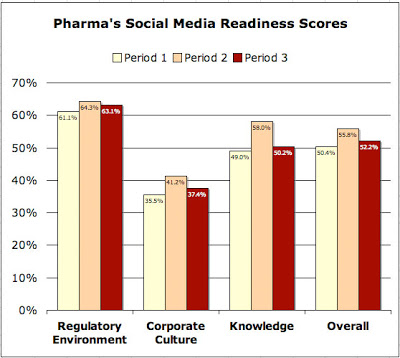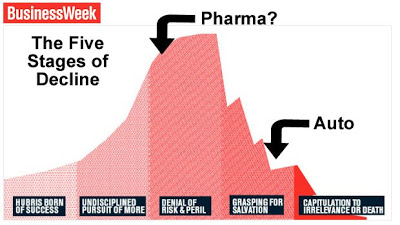At last night’s Philama (Philadelphia American Marketing Association PharmaSIG) panel discussion on “Pharmaceutical Marketing within Today’s Social Media Culture — Opportunity or Nightmare?” I found myself comparing the pharmaceutical industry to the auto industry.
Impossible!, you say. The pharmaceutical industry is at the top of its game with an average 17% gross and 22% net profit margin, according to panelist Thani Jambulingam, PhD, Chair and Associate Professional of the Department of Pharmaceutical Marketing at St. Joseph’s University (a great school, BTW).
Let me explain my thinking.
I am interested in the auto industry because my son just graduated with a BS in mechanical engineering and his dream was to work in the auto industry. When the proverbial sh*t hit the fan belt in that industry, I felt my son had no future there. Now, however, with the industry embracing Obama’s plan for fuel-efficiency, the auto industry will have the resources and, more important, the will or need to embrace change. I am hopeful that will spur renewed innovation in combustible engine development, which will require the industry to hire new, YOUNG, inspired engineers like my son.
At last night’s meeting, we all wondered what would be necessary for pharmaceutical marketers to embrace new technologies like Web 2.0 and social media. Of course, we talked about the usual suspects like overcoming regulatory barriers, but the main conclusion I heard was that it will take NEW, YOUNGER marketers who grew up with these technologies and who are passionate about them and cannot live without them.
You might recall these survey results that I published in the April 2009 issue of Pharma Marketing News, which seem to indicate that the new batch of marketers in pharma have LESS personal knowledge of new media than did the batch who filled out the survey a year ago:
 See “There’s a New Crop of Pharma People Who Are Not So Savvy About Social Media!” for more details.
See “There’s a New Crop of Pharma People Who Are Not So Savvy About Social Media!” for more details.It may be that the current crop of marketers within drug companies is a lost cause when it comes to social media. They have a “not invented here” mindset.
In the book “How the Mighty Fall,” Jim Collins identifies “Five Stages of Decline” that failed companies go through.
“Our comparative and historical analysis yielded a descriptive model of how the mighty fall that consists of five stages that proceed in sequence,” says Collins. “And here’s the really scary part: You do not visibly fall until Stage 4! Companies can be well into Stage 3 decline and still look and feel great, yet be right on the cusp of a huge fall. Decline can sneak up on you, and—seemingly all of a sudden—you’re in big trouble” (see excerpt here and chart below).
I place the pharmaceutical industry somewhere in the “denial of risk & peril” area of the curve

“As companies move into Stage 3, internal warning signs begin to mount, yet external results remain strong enough to ‘explain away’ disturbing data or to suggest that the difficulties are ‘temporary’ or ‘cyclic’ or ‘not that bad,’ and ‘nothing is fundamentally wrong,'” says Collins. “In Stage 3, leaders discount negative data, amplify positive data, and put a positive spin on ambiguous data. Those in power start to blame external factors for setbacks rather than accept responsibility. The vigorous, fact-based dialogue that characterizes high-performance teams dwindles or disappears altogether. When those in power begin to imperil the enterprise by taking outsize risks and acting in a way that denies the consequences of those risks, they are headed straight for Stage 4.”
There are all kinds of risks that the pharmaceutical industry faces. With regard to social media there may be MORE risk in NOT getting involved than staying on the sidelines, according to Philama panelist Stephan Wray, President & CEO of Cadient Group.
Another point made at last night’s discussion is that Social media will change marketing!
Currently, marketers PUSH well-honed messages out to TARGETS. It makes no difference if it’s called permission marketing or relationship marketing, it’s still a top-down approach where the approved message is pushed down to the masses.
In social media, however, the message comes up from the bottom and to be successful in that environment there has to be a revolution in marketing to accept these messages and try and steer the group toward the messages that support your brand. The new marketers are like sailors making the best of the wind they have to get to their destination. That’s quite different than today’s marketers who steer powerful tankers in any direction they choose. But, like today’s real tankers, they can be hijacked by a small, mobile crew of pirates. Just think of Andy Behrman versus BMS (see “Behrman Wasn’t the First Patient Spokesperson Paid Big Bucks By BMS“).
So, a revolution in marketing needs to occur before the drug industry can successfully engage in social media. How is that likely to happen?
 It won’t happen until the pharma industry, like the auto industry, reaches Stage 4 where it is “grasping for salvation.” It certainly won’t happen when profit margins are 22%. With that treasure chest, pharma companies do not have to react to the Andy Behrmans in the social media world. He’s just a gnat on the pimple of pharma’s ass.
It won’t happen until the pharma industry, like the auto industry, reaches Stage 4 where it is “grasping for salvation.” It certainly won’t happen when profit margins are 22%. With that treasure chest, pharma companies do not have to react to the Andy Behrmans in the social media world. He’s just a gnat on the pimple of pharma’s ass.
However, as the profit margins shrink — think comparative effectiveness — the social media gnat will look more like an albatross. Pharma will carry that albatross around its neck either into Stage 4 (capitulation) or they will embrace change from the top down just like the auto industry and possibly save themselves!








![6 Digital Tools at the Center of Healthcare Digitalization [INFOGRAPHIC]](http://ec2-54-175-84-28.compute-1.amazonaws.com/pharma-mkting.com/wp-content/uploads/2021/04/6DigitalTools_600px-100x70.jpg)




